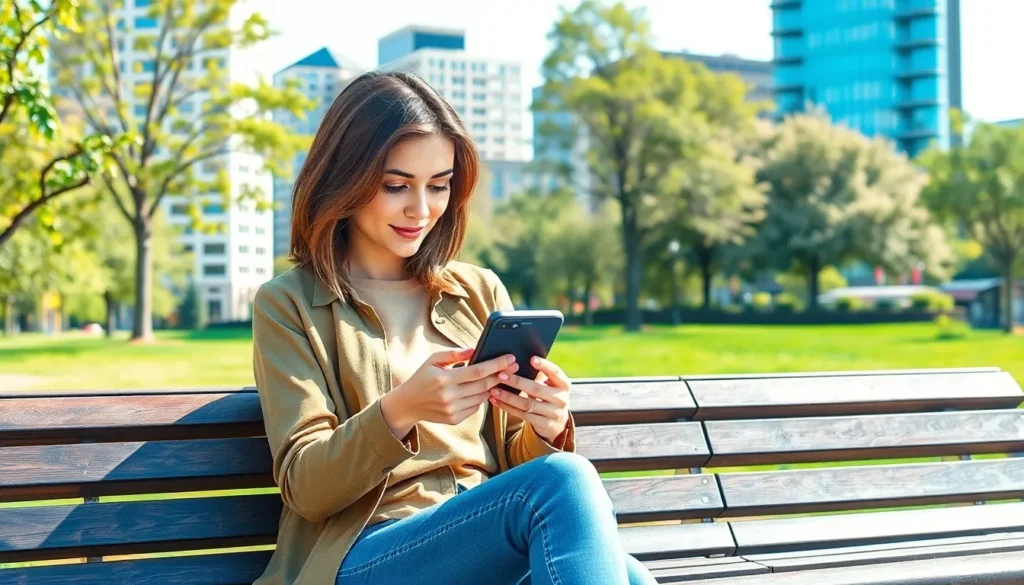Imagine blasting your favorite tunes from not one but two Bluetooth speakers, turning your living room into a mini concert hall. Sounds amazing, right? Connecting two Bluetooth speakers to your iPhone isn’t just a techy flex; it’s the secret sauce for elevating your audio experience.
Table of Contents
ToggleUnderstanding Bluetooth Technology
Connecting two Bluetooth speakers enhances sound quality. This technology plays a crucial role in creating a seamless audio experience.
What Is Bluetooth?
Bluetooth is a wireless technology that facilitates communication between devices. It operates over short distances, typically within 30 feet. Devices such as smartphones, headphones, and speakers utilize Bluetooth to transmit data without cables. Bluetooth uses radio waves to send information, allowing for clear audio quality. Versions of Bluetooth have evolved, improving speed and range. The latest iterations support higher data rates and reduce latency, making connections faster.
How Bluetooth Works
Bluetooth creates connections by pairing devices. When devices enter pairing mode, they exchange security codes to establish a secure link. Once paired, devices connect automatically when in range. Bluetooth operates in the 2.4 GHz frequency band, allowing multiple devices to connect without interference. Each device communicates through a unique identifier, ensuring distinct interactions. The technology utilizes frequency hopping to maintain stable connections in crowded environments. By adapting to environmental factors, Bluetooth enhances audio quality while minimizing drops.
Preparing Your iPhone
Preparing your iPhone is essential for connecting two Bluetooth speakers. This ensures optimal compatibility and functionality for enhanced audio playback.
Checking Compatibility
Checking compatibility remains crucial before proceeding. Most iPhones support connecting multiple Bluetooth speakers, but specific models and iOS versions excel in this feature. iOS 13 and later versions enhance audio features, allowing better management during connections. Confirm the Bluetooth speakers also support this capability. They should offer multi-pairing or stereo modes, enabling simultaneous playback. Look for speaker specifications such as true wireless stereo (TWS) support, which plays a vital role in achieving desired sound quality.
Updating Your iOS
Updating your iOS is another significant step. Running the latest version guarantees access to new features and optimized Bluetooth performance. To update, navigate to Settings, select General, and tap Software Update. Most updates occur automatically, but checking manually can prevent potential connection issues. Ensuring the device has sufficient storage opportunities before the update helps avoid complications. Regularly updating maintains device security and enhances overall functionality, which plays a key role in connecting multiple Bluetooth speakers.
Connecting Two Bluetooth Speakers
Connecting two Bluetooth speakers to an iPhone enhances the audio experience significantly. Various methods enable this connection, including using Apple’s native features or third-party applications.
Using Apple’s Native Features
Apple introduced a feature called Audio Sharing for iPhones running iOS 13 and later. This capability allows users to pair two compatible Bluetooth speakers simultaneously, providing an immersive sound experience. To connect, the user must first pair the primary speaker through the Bluetooth settings. Next, activating the Audio Sharing feature involves bringing the second speaker close and following on-screen instructions. Compatibility of the speakers matters for this to work, as not all Bluetooth speakers support Audio Sharing. This built-in functionality ensures seamless switching and improved sound quality across multiple devices.
Utilizing Third-Party Apps
Third-party applications offer alternative solutions to connect two Bluetooth speakers to an iPhone, especially when native features are unavailable. Apps like Bose Connect, JBL Connect, or Ultimate Ears MEGABLAST enable users to unify audio output across multiple speakers. These apps often require installation and setup via user-friendly interfaces, guiding users through the connection process. Many third-party options also include additional features, like customizable EQ settings and enhanced sound controls. For optimal performance, ensuring that the speakers are compatible with the chosen app remains crucial.
Troubleshooting Common Issues
Connecting two Bluetooth speakers can sometimes present challenges. Addressing connection problems and audio sync issues ensures a smoother experience.
Connection Problems
Several factors can affect Bluetooth connections. First, ensure both speakers are fully charged. Weak batteries can lead to unreliable connections. Next, checking the Bluetooth settings on the iPhone is essential. If the device isn’t discovering the speakers, turning Bluetooth off and on might resolve the issue. Additionally, interference from other devices can disrupt connections. Keeping other Bluetooth devices away from the speakers will help. Restarting the iPhone often clears temporary glitches, aiding in the connection process. Lastly, verify that both speakers are compatible with the expected pairing methods.
Audio Sync Issues
Audio sync problems may arise when using two Bluetooth speakers. First, ensuring both speakers support the same audio formats is critical. Different audio codecs can cause delays in sound playback. Adjusting the speaker settings through their respective apps may help minimize delays. If noticeable lag occurs, disconnecting and reconnecting the speakers can often resolve timing issues. Additionally, maintaining proximity between the iPhone and the speakers minimizes delays caused by distance. Lastly, controlling the audio settings on the iPhone may improve synchronization, enhancing the overall listening experience.
Conclusion
Connecting two Bluetooth speakers to an iPhone opens up a world of enhanced audio experiences. With the right setup and compatible devices users can easily transform their listening environment. Whether it’s through Apple’s Audio Sharing feature or third-party applications the process is straightforward and rewarding.
By ensuring compatibility and keeping devices updated users can enjoy seamless connections and superior sound quality. Troubleshooting common issues like battery life and interference can further enhance the experience. Embracing these methods allows anyone to enjoy rich audio whether at home or on the go. It’s time to elevate your sound experience and make the most of modern technology.










